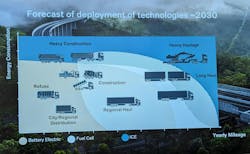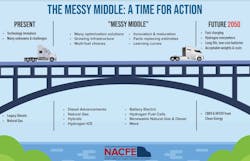GOTHENBURG, Sweden—The uncertain future of transportation isn’t just about what power systems will prevail; it’s about how fleets will make money with emerging yet unproven technologies. But after spending a week here, it’s apparent that Volvo Trucks believes the future of trucking profitability is green—because the world and the next generation are demanding it.
The OEM, which hosted North American transportation journalists here on Sweden’s western coast, showed how the company is creating a cleaner and safer future for trucking and is determined to successfully convert its 1.2 million trucks operating worldwide to carbon-neutral, or net-zero, equipment by 2040.
Volvo Trucks President Roger Alm said it is vital to move to net-zero, which the global parent of Volvo Trucks North America and Mack Trucks began in 2019.
“Because if you are not all moving to this situation on net-zero, we will not have this fantastic weather that we are having today, we will not have this world that we are living in today,” Alm said while looking out on a bright, sunny Gothenburg sky from a top-floor conference room at the new World of Volvo building.
“It will be something different,” he continued. “We need to take our responsibility. The society needs to take their responsibility. You, as you’re now listening, need to take your responsibility into this development because it’s all about what we are going to give to the next generation of people. Because are they interested in what kind of trucks we will drive? What kind of TCO there is on the trucks? What kind of range there is? They are not interested at all. They are interested in what we will give to them for the future. And we need to make this happen.”
Volvo executives conceded this week that this transition will not be easy, and they don’t yet know what alternative powertrain systems will win. However, they see three paths: battery-electric, fuel-cell electric, and renewable internal combustion engines.
It’s a challenge to change trucking, Kristina Nilsson, SVP of charging and infrastructure for Volvo Energy, acknowledged a couple of days later at CampX, Volvo Group’s start-up accelerator division on its sprawling Gothenburg campus.
“If you take North America, [which] is very unique, I would say that we need to do is to see that this new landscape requires different methodologies,” she said.
See also: GHG3 reality worries fleets
Comparing today’s transportation transition to yesterday’s
This week, Volvo executives pointed out several times that this is not the first time transportation has faced a massive makeover. More than once, they flashed a slide with two photos of New York City’s Fifth Avenue: One taken in 1900 full of horse-drawn carriages and the same thoroughfare just 15 years later packed with automobiles.
That timeframe is what Volvo Group and its rival OEMs with similar Paris Accord plans to decarbonize by 2040 have left. Volvo leaders note that its trucks tend to have 10-year lifecycles, so to meet the complete carbon-free goals of 2050, it has to replace all its diesel-burning equipment a decade earlier.
But moving from horse-drawn carriages to automobiles made much more sense a century ago: The internal combustion engine is far more efficient than a horse. Today, companies like Volvo must convince skeptical transportation companies that nascent power technologies will help them be profitable. Most North American fleet leaders see zero-emission transportation as a much more expensive, complicated way to move goods across our vast continent. Just look at the massive Clean Freight Coalition study that warned it would cost $1 trillion to electrify the U.S. trucking industry.
Nearly a third of Americans oppose the U.S. taking steps to become carbon neutral by 2050. If you polled the trucking industry, that number is much higher. When I asked our readers last year if we were spending too much time focusing on EVs here at FleetOwner, many of you told me that you don’t want to read about electrification because you can’t see it ever making sense in your operations.
See also: Forget the carrot. EPA uses stick
However, the way to trucking’s heart is through its wallet—not its heart. Much of the industry back in the States simply sees more costs when going green. But Volvo sees it differently (as do a majority of Americans, by the way).
Volvo leaders this week noted that more companies are looking for greener transportation because their customers, who don’t know or care how complicated it is, are demanding it. While many fleets can’t see how BEVs, FCEVs, and H2 ICE will help them make more money tomorrow, Volvo believes that its customers who embrace the path of zero will ultimately win out. That is because people, including two-thirds of the U.S., who want more alternative fuel development will demand it.
“They need to improve their margins, and they need to be able to make this type of investment,” Lars Mårtensson, Volvo Trucks’ director of environment and innovation, said. “And if we look at most of our customers, especially in Europe, they are small and medium-sized companies that can’t take risks. They can’t take big investments if they are not sure that this can be profitable going forward.”
So, how does Volvo plan to win the hearts and minds of its American skeptics and potential customers, who see green energy as more of an enemy than a solution?
“It is obvious that when we come up with new technology and new solutions, it has to have value for our customers,” Mårtensson said. “They need to be willing to pay, and they need to see that this adds something to their business. And if it’s too costly and there’s no business case, we need to enhance incentives there.”
Right now, our transportation industry is in what the North American Council for Freight Efficiency calls the “Messy Middle.” Truck makers like Volvo are focused on exploring all sorts of solutions because our days of one dominant fuel are over, as the State of Sustainable Fleets report ominously declared a year ago: The sun is setting on the Diesel Era, and there is no one true path forward.
Battery electric works better for regional routes, while hydrogen, biodiesel, and other renewables are more likely to power long-haul transportation.
“All these different things, including the availability of energy, will determine how fast certain things will go,” Mårtensson added. “Remember, we will not see it overnight like the New York example. Maybe it will take a longer time. But it can also depend on where we are in the world.
“In order to make this happen, in a way, we need to recognize that we are in a quite conservative industry. Our customers are used to having excellent efficiency running this type of truck,” he said while pointing at a diesel-powered Volvo FH16 heavy-duty European cabover on display in the Volvo Trucks global headquarters lobby.
See also: Volvo shows off how all-new VNL is designed to make fleets more green
A potentially profitable leap of faith
The trucking industry operates on thin margins, and most fleets can’t afford to take a leap of faith just because it might benefit the planet. They are thinking about what will help them get through this quarter.
“There are different ways to address this, and one is to obviously demonstrate that this type of new technology is working," Mårtensson said. "Our customers who test this early are also part of the journey together with us to scale this up.”
Volvo expects its early-adopting fleets to show off how its BEV and fuel-cell technology can scale up. “We need to have customers who dare to test it and show others in the industry that this is working," Mårtensson said."
Possibly the biggest driver of decarbonization is fleet customers—or, as Mårtensson called them, “our customer’s customers, the transport buyers.”
“I think they would play an extremely important role because they really set the conditions for our customers. I think many of them also have very clear objectives where they want to go," Mårtensson said.
He said that the shippers and corporations looking for more sustainable goods movements are going to support the fleets at the forefront. “Together, we need to demonstrate this is working and that this makes good business as well. It’s not only good for the environment but also good for the business.”
In the U.S., a general fear is that these more expensive yet decarbonized transportation technologies will trickle down to Volvo Trucks’ customers’ customers’ customers—the consumers. How much can they be pushed to pay more for goods hauled by electric trucks?
“This is tricky—especially since there still are people in society that really don’t believe in the science,” Mårtensson said.
See also: Diesel’s dominance continues as trucking plans clean energy shift
While he agrees that trucking’s decarbonized future could drive up consumer costs in the near term, he doesn’t believe it will be as outlandish as some fear.
“The challenge for the transport sector is that if we add the cost of this new technology, and when we transfer that to the consumer when we transport a bottle of water or something, then the transport costs is quite small in that," Mårtensson said. "So, in a way, we need to transfer costs and I think that, in the end, it will not be a significant cost for the end consumer.”
The future of business is green. Despite a healthy chunk of Americans either not believing in or caring about climate change, most want the peace of mind of not being part of the problem. Volvo believes that those consumers here in Europe and across the globe will be the driving force for fleet transformation and profitability.
Just like Americans in 1900 didn’t know what business opportunities lay ahead for the auto industry, we also don’t know what new revenue potential a green transportation economy could create in the years to come. Just like New Yorkers in 1900 couldn't fully grasp what Fifth Avenue would like in 15 years, maybe we still can't fathom what Fifth Avenue will look like in 2050.









